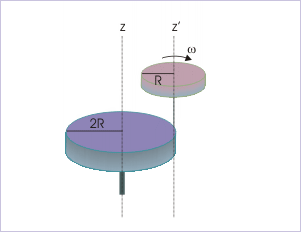| << Chapter < Page | Chapter >> Page > |
Example 4
Problem : Two uniform disks of masses “4M” and “M” and radius “2R” and “R” respectively are connected with a mass-less rod as shown in the figure. Initially, the smaller disk is rotating clockwise with angular velocity “ω” with the help of an electric motor mounted on it, whereas the larger disk is stationary. At an instant, the smaller disk reverses the direction of rotation, keeping its angular speed same. Find the angular velocity of the larger disk.
Rotations about two parallel axes

Solution : This question involves two axes of rotation : one for "larger plus smaller disks" (z-axis) and other for smaller disk (z’-axis). The treatment of angular momentum, in this case, differs from other cases in one important aspect. The constituents of the system are defined with respect to axis of rotation – not with respect to objects.
The body about the z - axis is a composite body comprising of larger and smaller disks. The smaller disk is also part of this composite body. The smaller disk (part of the composite body) rotates about its own axis (z’) parallel to z-axis. In the nutshell, the system comprises of two rotating bodies :
We should note that the MI of the composite body is constant and is independent of the motion of smaller disk, because mass distribution about z-axis does not change by the rotation of smaller disk. It is so, because disks are uniform and circular in shape.
Now, let us check external torques on the system. The weight of smaller disk constitutes a torque, but it is perpendicular to the axis of rotation. Further, the torque due to smaller disk is balanced by an equal an opposite torque applied on the axle by the ground. This is confirmed, as there is no rotation of smaller disk in vertical plane. As such, we can conclude that there is no torque on the system in vertical direction and, therefore, we can apply law of conservation of momentum about z and z’ axes. Since two axes point in the same direction, the net angular momentums "before" and "after" are simply the arithmetic sum of angular momentums about the two axes. Let “C” and “S” subscripts denote the composite body and smaller disk respectively, then :
The moment of inertia of the smaller disk about z’-axis is :
Now, the moment of inertia, “ ”, of the composite body is given by the theorem of parallel axes as :
Let “ ” be the final angular velocity of the composite body. Substituting in the equation of conservation of angular momentum,
Negative sign indicates that smaller disk rotates in clockwise direction.
Example 5

Notification Switch
Would you like to follow the 'Physics for k-12' conversation and receive update notifications?